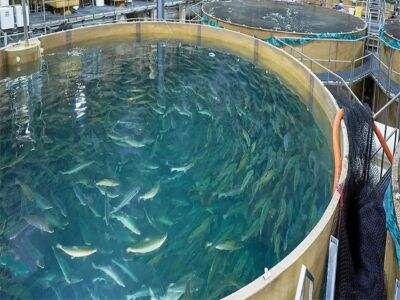End-to-End rekjaanlegni í nútímalegum endurunnandi akvakultúrum
End-to-end rekjaanlegni er lykilatriði í stóru myndinni varðandi fisk og sjávarafur. Í ljósi þess að áhyggjur um sjálfbærni og mataröryggi eykst, verða neytendur líklegir til að krefjast meira upplýsinga um uppruna sjávarafuranna sína. Wolize skilur gildi rekjaanlegrar kerfis og hefur lausnir sem tryggja að kaupendur og rekstrar í akvakultúr haldi reikningi.
Lausnir fyrir rekjaanleika fyrir veitingahusa í akvakultúr
Wolize býður upp á fullan úrval af sporanlegjulausnum fyrir heildsvöruhverslana í sjávarfararauðlindum sem saman tryggja fulla sporanleika af sjávarafurðum frá bænum, í gegnum vinnslu og dreifingu, að sölu. Með nýjasta tækni eins og RFID merkjum, strikamerkjum og blockchain tekur Wolize ábyrgð á því að allar framleiðslustig geti verið reknuð og staðfest. Vegna þessarar skráningar vitna kaupendur hvort vara séu af góðri gæðum og hvert þær koma frá. Til dæmis fá verslend sem skanna QR-kóða á umbúðum af fisk fljótlega upplýsingar um hvar hann var reistur, hvernig hann var veiddur og hvenær hann var unninn. Þessi hátt lýðsýni aukar trausti hjá kaupendum og festir Wolize sem leiðtoga í bransjinu í sviði sporanleika fyrir sjávarfuglasafnun vörumerkin.
Hvernig heildsvöruhverfingar í sjávarfararauðlindum geta nýst af endahnýtum sporanleika
Ávinningar í veiðifiskeldi eru miklir ef full traceability hugtakið er útfært. Frá eggjum til frumkvöðuls, ungu fiski til framleiðslu – hvert sem er mælt er á framleiðslu matvæla (fyrir egg og þroskunaregg), er hægt að greina innaflæki sem leita til minnkunar á waste. Til dæmis getur rekstur notað gögn úr sporanlegu lausn til að hámarka fóðrun, fylgjast með vatnsástandi og tryggja samræmi við reglugerðir. Auk þess getur sporanleiki verið lykilatriði í endurnýjunarátökum, svo reksturinn geti fljótt takmarkað svæðið sem veldur áhyggjum og gripið til viðeigandi ráðstafana. Á meðan við vorum að vinna í þessu rekstri, byrjaði Wolize að reka fjársekt í sporanlegar lausnir sem gætu hjálpað fisk- og reyktidýraframleiðendum sem starfa í stórum sölum. kerfi fyrir fiskeldingu bændur að straumlinja rekstur sinn, bæta matvælasöfnuði og samtímis bjóða fram um heppni fyrir gæði og gegnsæi.
Algeng vandamál í aquaculture sporanleika kerfum og hvernig á að leysa þau
Í fiskeldi er sporanlegging grunnkrafa til að tryggja öryggi og gæði afkomu úr fiskeldi. Hins vegar eru ýmis vandamál í leiðinni sem fiskeldisbændur geta lent í þegar beitt er sporanleggingu „frá garði til diskar“ í rekstri sínum. Eitt stóru vandamálið er vantað á staðlaðum kerfum sem mismunandi kerfi geta notað til að spára eftir gögnum og skráa þau um margar millilaga í birgðarleiðum. Þetta getur leitt til bila í uppfylgni og gerst erfitt að rekja uppruna vöru ef hún verður arnað eða hefur önnur vandamál.
Til að leysa þetta má investera í stafræn lausnir fyrir sporanleggingu, svo sem þær sem Wolize býður upp á. Slíkar lausnir nýta sér tækni eins og RFID-merki og blockchain til að fylgjast með sjávarafurðum frá eldri til matarborðs. Með því að stafræna ferlið í sporanleggingu geta bændur tryggt að allar nauðsynlegar upplýsingar séu réttar og tiltækar ef þarf.
Bestar aðferðir til að útfæra enda-til-enda rekistréttleika í akvakultúr
Þegar enda-til-enda rekistréttleiki er innleiddur í akvakultúru, eru nokkrar bestu aðferðir sem landbúar ættu að hafa í huga til að gera umskiptin slétt og vel heppnast. Ein mikilvæg hefð er að setja upp skýr áferðir og reglur fyrir söfnunaraðila og skrásetjendur. Þetta felur í sér: að leiðbeina starfsfólki um réttan notkun rekistréttleikakerfa; nákvæma og tímalega skráningu á gögnum.
Aðrar bestu aðferðir eru reglulegar yfirferðir og fljótar kíkjur á rekistréttleikarkerfin til að finna villur sem gætu verið í gögnunum. Með því að athuga reglulega geta landbúar tryggt að rekistréttleikarkerfið virki vel og leyst vandamál fljótt upp. Auk þess er mikilvægt að hafa skýra samskipti við alla aðila í birgðarkeðjunni svo að allir séu sammála og skilji áhrifin af rekistréttleika.
Hvernig mun enda-til-enda rekistréttleiki stuðla að sjálfbærni í akvakultúrudrift?
End-to-end ábyrgð veitir leið til að hækka stöðuvarnarmerki varanleika í samvinnufiskifóstri . Með því að fylgjast með sjávarafurð frá upprunastaði hennar í hafinu og að borðinu, geta bændur fundið leiðir til að minnka aragræði, reksturinn á öruggri hátt og minnka áhrif á umhverfið. Til dæmis getur sporanleggingargögn hjálpað stjórnendum bænda að greina svæði sem nota mikið orkubinding eða eyða vatni og hefja lagabreytingar.
Það er einnig möguleiki á að notkun sporanleikunar leyfi bændum að tryggja að vörurnar komi frá umhverfisvænum og ábyrgum heimildum. Með því að rekja uppruna vöru svo hægt sé að tryggja að allt komi frá bænum geta bændur sagt með vissu hvort hún var framleidd á varanlegan og etískan hátt. Þetta gæti einnig haft markmið um að mynda treyðingu og trúnað við vörur Wolize, og á þann hátt að leita til almennrar varanleika í akvakultúruiðgreiðslu.
Efnisyfirlit
- End-to-End rekjaanlegni í nútímalegum endurunnandi akvakultúrum
- Lausnir fyrir rekjaanleika fyrir veitingahusa í akvakultúr
- Hvernig heildsvöruhverfingar í sjávarfararauðlindum geta nýst af endahnýtum sporanleika
- Algeng vandamál í aquaculture sporanleika kerfum og hvernig á að leysa þau
- Bestar aðferðir til að útfæra enda-til-enda rekistréttleika í akvakultúr
- Hvernig mun enda-til-enda rekistréttleiki stuðla að sjálfbærni í akvakultúrudrift?












































